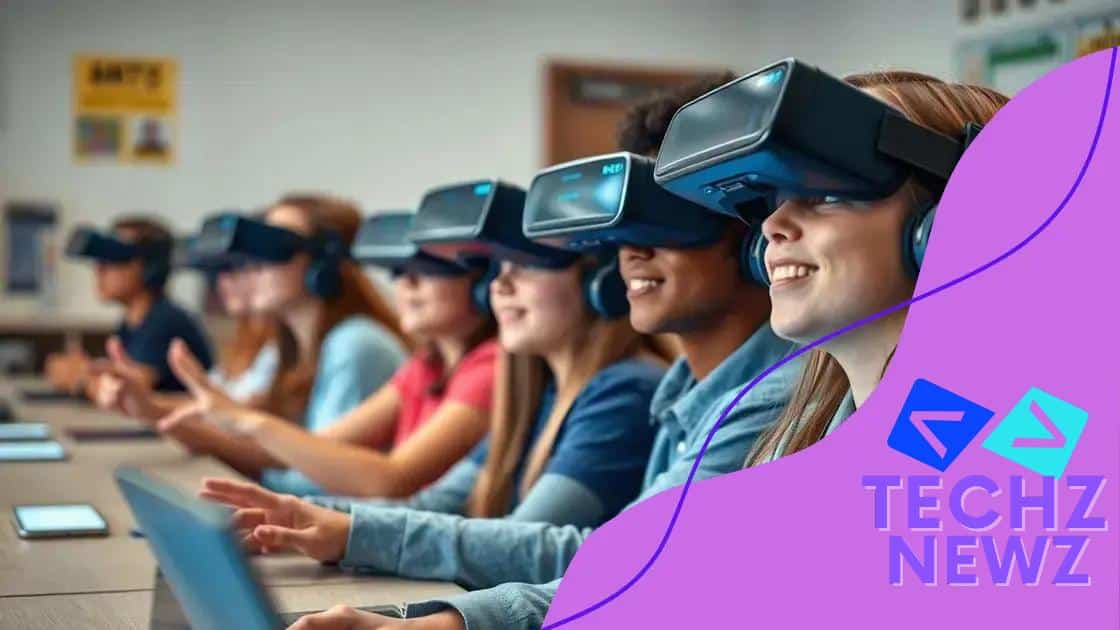Augmented reality in interactive online learning

Augmented reality in interactive online learning enhances engagement, personalizes experiences, and provides immersive educational tools that facilitate collaboration among students.
Augmented reality in interactive online learning is changing the educational landscape, allowing students to engage with materials like never before. Imagine exploring historical sites or conducting virtual science experiments right from your home. Let’s dive into how this technology is reshaping learning.
Understanding augmented reality
Understanding augmented reality (AR) is crucial as it transforms the way we interact with digital information. AR merges the real world with virtual elements, enabling users to experience a different dimension of learning. Imagine wearing glasses that superimpose digital images onto your physical surroundings, helping you understand complex concepts effortlessly.
What is Augmented Reality?
At its core, augmented reality enhances our perception of reality by adding computer-generated graphics, sounds, and other sensory inputs. By overlaying digital content onto the real world, it creates an interactive experience that boosts engagement and understanding.
Key Components of Augmented Reality
- Hardware: Devices like AR glasses or smartphones help deliver augmented experiences.
- Software: Applications designed to merge physical and digital realities, enhancing user interaction.
- Sensors: Tools that detect user movements and adjust virtual content accordingly.
- Display: Screens or lenses that showcase digital overlays in the real-world environment.
As you can see, integrating augmented reality into learning environments offers numerous benefits. It facilitates a deeper understanding of subjects by allowing learners to visualize complex ideas or concepts. For instance, in a science class, students can use AR to see the internal structures of the human body in a way that traditional methods cannot provide.
Furthermore, the applications of AR extend beyond education. In fields like medicine, AR allows for real-time feedback during surgeries, improving training for medical students. In architecture, AR visualization helps designers see how a building fits within its environment before it’s constructed. This transformative technology is paving the way for more engaging, efficient learning experiences.
Benefits of Augmented Reality in Learning
With the rise of online education, augmented reality offers exciting improvements:
- Increased student engagement through interactive content.
- Improved retention rates as students visualize and interact with learning materials.
- Accessible learning experiences for students regardless of location.
Overall, understanding augmented reality is essential in adapting education for future learners. With its capacity to enhance engagement and understanding, it’s a powerful tool that educators and students can leverage together.
Benefits of using augmented reality in online learning
The benefits of using augmented reality in online learning are numerous and impactful. With the ability to blend the digital and physical worlds, AR enhances the educational experience significantly. Students find themselves more engaged and motivated to learn through interactive content.
Enhancing Engagement
One of the key advantages of augmented reality is its ability to captivate students’ attention. Traditional learning can sometimes lead to disengagement, but AR can pull students into a world of interactive exploration. For instance, imagine students learning about ancient civilizations by observing 3D models of structures that pop up right in their living rooms.
Improving Retention Rates
Studies show that when learners engage with materials in a hands-on manner, they retain information better. This is where AR shines. By visualizing concepts such as complex scientific processes or historical events, students can create mental maps that help them remember what they’ve learned.
- Realistic simulations: Students can practice skills in a safe, controlled environment.
- Visual aids: Complex information is simplified through visual representations.
- Interactive feedback: Immediate responses help learners adjust and refine their understanding.
This method of learning fosters deeper understanding and minimizes the struggle to memorize facts alone. Instead, students build connections and insights that last. Furthermore, augmented reality lowers barriers to access, providing unique educational experiences to students regardless of their location.
Promoting Collaboration
Another highlight of AR in education is its ability to facilitate collaboration among students. When using AR tools, learners can work together in real-time, even if they are miles apart. This collaborative aspect not only encourages teamwork but also enhances communication skills as they share ideas and solve problems together.
- Group projects: Students can collaborate on shared AR experiences.
- Peer learning: Articulating concepts to others strengthens understanding.
- Global perspectives: Learners can connect with peers worldwide, fostering cultural exchange.
With these remarkable benefits, augmented reality is paving the way for a more interactive, effective, and engaging online learning environment.
Implementing augmented reality in online courses

Implementing augmented reality in online courses can transform the learning experience for students. This integration involves using AR technology to create immersive learning environments that engage users. By incorporating AR, educators can visualize complex topics and provide interactive content that captures students’ attention.
Steps to Implement Augmented Reality
Implementing augmented reality requires careful planning and execution. Here are some essential steps:
- Identify learning objectives: Determine what you want students to learn and how AR can enhance this experience.
- Select appropriate AR tools: Choose applications or hardware that best fit your course content and learning goals.
- Design AR experiences: Create engaging AR content that aligns with the curriculum, making it interactive and informative.
- Test and refine: Pilot the AR components before full implementation, gathering feedback and making adjustments.
As AR becomes more mainstream in education, educators can leverage this technology to create real-time interactions. Interactive 3D models bring subjects to life, allowing students to explore and manipulate objects from multiple angles. This not only increases retention but also encourages self-directed learning.
Challenges in Implementation
While implementing augmented reality has its benefits, it also comes with challenges. Ensuring everyone has access to the necessary technology can be difficult. Instructors and students need compatible devices, which might require additional resources.
Training teachers to effectively integrate AR into their teaching strategies is another hurdle. Providing professional development can help educators feel confident in using new tools. Furthermore, it’s important to keep learning outcomes in sight; the use of AR should not overshadow the core educational goals.
Even with these challenges, the potential impact of augmented reality in online courses is immense. By embracing this immersive technology, educators can foster a dynamic learning environment that adapts to students’ needs.
Real-world examples of augmented reality in education
There are many exciting real-world examples of augmented reality in education that showcase its potential. Schools and organizations around the world have embraced this technology to enhance learning experiences. These innovative approaches are not only improving engagement but also making complex subjects easier to understand.
Case Studies of Augmented Reality in Action
One notable example is the Google Expeditions app, which allows students to take virtual field trips. Wearing a headset, learners can explore historical sites, underwater worlds, and even outer space, all from their classroom seats. This immersive environment sparks curiosity and offers a hands-on approach to learning.
Interactive Learning with 3D Models
Another impressive use of augmented reality is in science education. Applications like Merge Cube let students hold a physical cube while viewing 3D models on their devices. For instance, they can explore the solar system or dissect virtual frogs, making complex content more relatable and understandable. Such interaction helps to reinforce learning by enabling students to visualize and manipulate information.
- The Smithsonian’s AR app: Offers interactive experiences that allow visitors to engage with exhibits from different angles.
- Human Anatomy Atlas: Enables students to explore the human body in 3D, enhancing their understanding of anatomy.
- AR history games: Allow students to interact with historical figures and contexts, making history lessons lively.
Schools that implement augmented reality find that students are more motivated and eager to learn. This technology also fosters collaboration among students, as they often work together in AR experiences. By sharing discoveries and insights, they build critical thinking and teamwork skills.
Future Perspectives on Augmented Reality in Education
As technology evolves, expectations for augmented reality in education continue to grow. Future applications may include personalized learning experiences that adapt to individual student needs. This means that AR could help create tailored educational paths that cater to each learner’s strengths and weaknesses.
As seen from these real-world examples, the integration of augmented reality in education is not just a trend. It represents a shift toward more interactive and engaging learning methods that can significantly impact student outcomes.
Future trends in augmented reality for learning
The future of augmented reality in learning looks bright. As technology advances, educational tools become more interactive and engaging. This evolution promises to reshape how learners absorb information, making education more personalized and effective.
Personalized Learning Experiences
One significant trend is the shift toward personalized learning. With AR, educational experiences can be tailored to fit individual student needs. Imagine a classroom where each student interacts with curriculum content specifically designed for their learning pace and style. This customization fosters better understanding and retention of information.
Increased Accessibility
Another trend is the increased accessibility of augmented reality tools. As technology becomes more affordable, schools around the globe can implement AR platforms. This accessibility broadens educational opportunities, allowing more students to benefit from interactive learning experiences regardless of their background.
- Mobile applications: Many AR learning tools will become available on smartphones, enabling learning anywhere, anytime.
- Cloud-based resources: Collaborative tools will allow students and teachers to create and share AR content easily.
- Integration with AI: Combining AR with artificial intelligence can provide adaptive learning experiences that respond to individual student progress.
The integration of AR into different subjects holds great promise. For instance, students studying history might explore ancient civilizations through AR simulations, while science students can visualize complex chemical reactions. These interactive experiences make learning more engaging and memorable.
Collaboration and Community Learning
Future trends also emphasize collaboration in AR learning. As more students use AR platforms, they can work together on projects regardless of their physical locations. This connectivity promotes teamwork and enhances communication skills. Students can tackle challenges together, contributing their unique perspectives to solve real-world problems.Augmented reality environments will become hubs for collaborative learning.
With these exciting developments on the horizon, it’s clear that augmented reality is set to revolutionize the educational landscape. As technology continues to advance, educators must embrace these opportunities to create vibrant and innovative learning experiences.
FAQ – Questions about Augmented Reality in Learning
What is augmented reality in education?
Augmented reality in education is a technology that enhances learning experiences by overlaying digital information onto the real world, making lessons more interactive.
How can AR improve student engagement?
AR captures students’ attention by providing immersive experiences, allowing them to explore subjects in a hands-on and enjoyable way.
What are some examples of AR applications in schools?
Examples include Google Expeditions for virtual field trips, Merge Cube for interactive 3D model exploration, and anatomy apps that visualize the human body.
What future trends can we expect in AR for education?
Future trends include personalized learning experiences, increased accessibility through mobile apps, and enhanced collaboration among students using AR tools.





